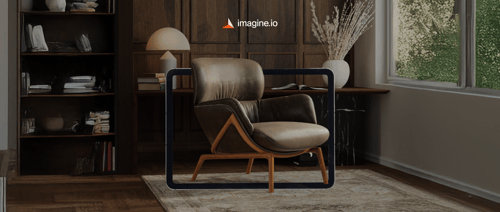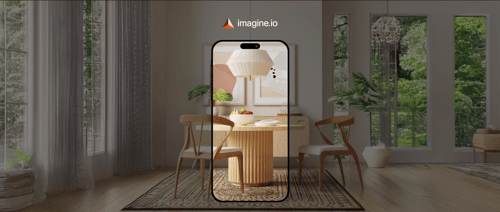What if your product pages could close the sale before your team even follows up? In today’s digital-first landscape, B2B buyers expect more than static product shots and spec sheets. They want clarity, customization, and confidence—all before making a decision.
That’s where 3D product visualizations are changing the game. By transforming how products are presented online, 3D visuals bridge the gap between in-store experiences and digital touchpoints. They reduce guesswork, shorten decision cycles, and significantly increase conversions. In this blog, we’ll explore how 3D visual content drives results—and how businesses like yours can leverage it to scale faster and sell smarter.
Get the latest updates straight to your inbox.
By clicking sign up you'll receive occasional emails from imagine.io. You always have the choice to unsubscribe within every email you receive.
Why Visuals Matter More Than Ever
Before we jump into 3D, let’s ground ourselves in a key truth: visual content drives decision-making. According to a study by Adobe, 91% of online shoppers say visuals are the most important factor in their buying decisions.
Traditional imagery might show what a product looks like—but 3D visualizations show how it feels, functions, and fits into a real-life setting. That distinction makes all the difference.
What Are 3D Product Visualizations?
3D product visualizations are digital representations of your products built using 3D modeling and rendering technologies. Unlike flat images, 3D visuals offer interactivity, personalization, and realism that mimic in-store experiences.
Key formats include:
- 360-degree spins
- Interactive configurators
- Augmented Reality (AR) previews
- Photorealistic 3D renders
- Exploded views (especially for complex products)
These assets aren’t just flashy—they’re functional. And they’re proving their worth across every stage of the buyer journey.
How 3D Product Visualizations Drive Conversions and Cut Costs for Modern Businesses
1. Increase Buyer Confidence with 360-Degree Spins
One of the biggest reasons shoppers abandon their carts is uncertainty. “Will this product look the same in person?” “What does the back look like?” “How does it work?”
With 360° product spins, customers can rotate and view every angle of a product in real-time—no guessing required.
Case in point: Brands using 360-degree visualizations have seen conversion rates increase by up to 47%, according to a report from Adobe Commerce.
How imagine.io helps:
imagine.io lets you generate 360° product spins in minutes using a single 3D model—no need for elaborate photoshoots or expensive studio setups.
2. Personalization That Drives Conversions: Product Configurators
Personalization isn’t a luxury anymore. It’s an expectation. Product configurators allow customers to choose colors, materials, finishes, and features—right on your PDP.
This hands-on control doesn’t just improve UX. It reduces returns and builds emotional investment in the product. In fact, Deloitte found that 1 in 5 customers is willing to pay a 20% premium for personalized products.
Why this works:
- Enables buyers to "see" their exact variant
- Cuts down back-and-forth for sales teams
- Reduces purchase hesitation
With imagine.io, your team can create AI-assisted product configurators that update visuals in real-time as shoppers explore variants—no code required.
3. Reduce Returns by Setting Realistic Expectations
Returns are costly. Especially for bulky or custom-made items.
Many returns stem from unmet expectations: “It looked different online.” That’s where 3D visualizations shine. Photorealistic renders show accurate textures, lighting, and scale—ensuring customers know exactly what they’re getting.
AR visualization takes it a step further by letting users place products in their own space through their smartphone camera. This is particularly useful in categories like furniture, appliances, and décor.
Retailers using AR have reported return rates dropping by up to 25%.
4. Speed Up Decision-Making with Exploded Views and Internal Cutaways
For products with complex structures—think mattresses, electronics, or mechanical parts—exploded views provide a clean, educational breakdown. They show internal layers, components, and assembly without overwhelming the viewer.
This is especially useful in B2B sales, where technical buyers need to understand how something works, not just how it looks.
imagine.io’s Mattress Builder, for example, lets users toggle between external views and exploded diagrams effortlessly. This not only empowers buyers—it shortens sales cycles by answering technical questions upfront.
5. Shorten the Path to Purchase with Interactive Layouts
The goal of your PDP should be clear: move the buyer from interest to action—fast. Interactive 3D layouts and contextual scenes help you do that.
Instead of clicking through galleries, shoppers can explore the product in its natural setting (a bedroom, a retail display, a kitchen). These contextual visuals speed up comprehension and eliminate mental friction.
In fact, brands using lifestyle renders report 2x higher engagement rates than those using plain white-background photos.
6. Scale Content Production Without Compromising Quality
Here’s where 3D visualization becomes a strategic advantage.
Creating hundreds of photos manually is time-consuming and expensive. But with a single 3D model, you can generate thousands of variations—colors, lighting, scenes, and more—within hours.
This agility is crucial for B2B teams managing large catalogs, seasonal updates, or multiple SKUs.
Why AR on Product Pages Works
Let’s break down why AR belongs on your product pages—today, not tomorrow.
-
Engagement Boost
Interactive product views hold attention longer. The average time spent on product pages with AR is up to 2x higher than traditional pages. More time = higher intent.
-
Informed Decisions
AR offers contextual clarity. Shoppers can view size, scale, color, and texture in real-time. This reduces post-purchase dissonance and gives buyers confidence to proceed.
-
Brand Differentiation
AR elevates your customer experience. It signals innovation, quality, and a customer-first mindset—key factors in how modern buyers evaluate brands, especially in B2B sectors.
-
Return Reduction
Misunderstood products often come back. By bridging the expectation gap, AR helps ensure the right product goes to the right customer, the first time.
-
Easily Usable to Your D2C Site or Your Marketplaces
Leverage an easy QR code / AR viewer powered by imagine.io on your own D2C website to get the above benefits or leverage an imagine.io-supplied Khronos validated model to a marketplace that accepts 3D data.
Easy Setup, Big Impact: Getting Started with AR

You don’t need a massive dev team or a six-figure budget to bring AR to life. With imagine.io, onboarding is fast and intuitive:
- Upload your existing 3D models or use built-in tools to create new ones
- Tag the models with product data
- Instantly generate embeddable AR experiences
The platform supports scalable rollout—so you can start small (think: your bestsellers) and expand as you see traction. And if you don’t have 3D models? No problem. imagine.io’s team can help convert your photos or CADs into high-quality, AR-ready assets.
Conclusion: The Future of Product Pages is 3D
Buyers today want more than a product—they want an experience. If your brand isn’t using 3D product visualization, you’re not just behind the curve—you’re leaving money on the table.
From increasing confidence and reducing returns to enabling personalization and shortening sales cycles, 3D assets are no longer optional. They’re essential for B2B brands looking to scale with precision and style.
Ready to see it in action? Don’t just take our word for it. Experience how 3D can transform your visual content strategy. Book a Demo with imagine.io.


.gif?width=1296&height=1296&name=Untitled%20design%20(8).gif)




.png?width=500&name=How%20to%20Add%20a%203D%20Product%20Configurator%20to%20Your%20WordPress%20Website%20(Complete%20B2B%20Guide).png)
















%20(1).png?width=500&name=Why%20Exploded%20Mattress%20Views%20Matter%20(And%20How%20to%20Generate%20Them)%20(1).png)
.png?width=500&name=Best%20Shopify%20Product%20Configurator_%20How%20to%20Choose%20the%20Right%20One%20(2).png)
.png?width=500&name=Why%20Exploded%20Mattress%20Views%20Matter%20(And%20How%20to%20Generate%20Them).png)



.png?width=500&name=Best%20Shopify%20Product%20Configurator_%20How%20to%20Choose%20the%20Right%20One%20(1).png)







.png?width=500&name=How%203D%20Rendering%20Can%20Make%20or%20Break%20Your%20Industrial%20Design%20Pitch%20(1).png)








%20with%20Digital%20Twins%20and%203D%20Visualization.png?width=500&name=Optimizing%20Your%20Digital%20Asset%20Management%20(DAM)%20with%20Digital%20Twins%20and%203D%20Visualization.png)




.png?width=500&name=Styling%20Home%20Decor%20for%202025_%20From%20Global%20Influences%20to%20Playful%20Personalization%20(1).png)
